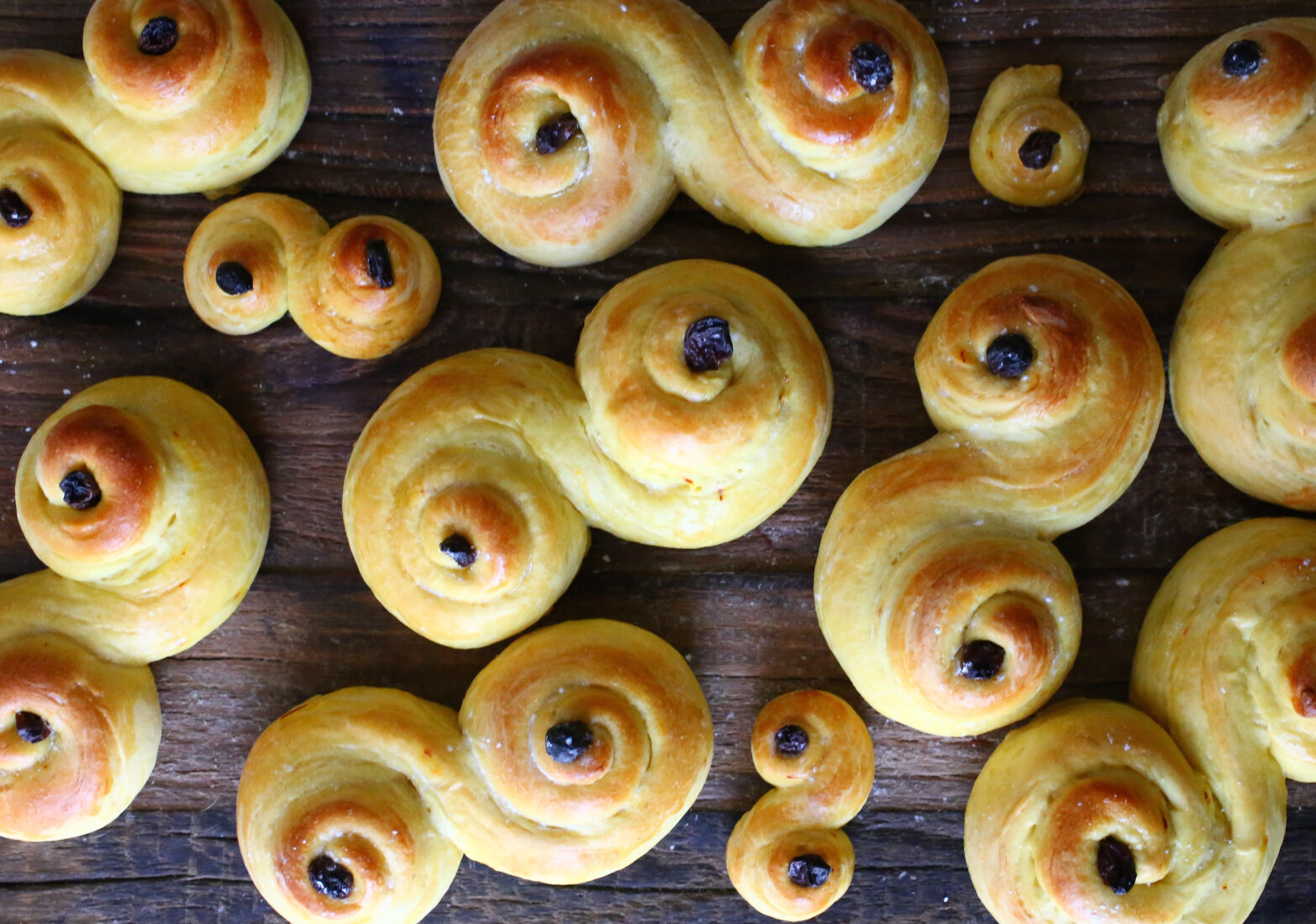Celebrating St. Lucy Day
Who is St. Lucy?
St. Lucy was born around 283 CE in Syracuse, Sicily during the Diocletian Persecution. She was born into a devout noble family and from a young age pledged herself to God, choosing to remain unmarried so that she could instead give her dowry—and her life—to the poor and suffering. Her mother, however, had different plans for Lucy and arranged for her to marry a wealthy pagan man. When Lucy refused, he reported her as a Christian to the authorities. Refusing to recant her faith, Lucy was martyred—gruesomely. If you want to read about it, you can do so elsewhere, but let’s just say she’s the patron saint of eyes for a reason.
Artwork from Jen Olson’s Etsy Shop
Even if you don’t know of St. Lucy, you can likely picture how she is often depicted: a young blonde girl dressed in white robes, a red sash around her waist, and a wreath of candles adorning her head. This image comes from the legend that she would take food and aid to the Christians living in the catacombs. Under the cover of darkness, she would wear a wreath of candles on her head to light the way—her hands were so filled with supplies. Her white dress is a baptismal robe, the red sash, symbolic of the blood of her martyrdom, and the candles signal the light of Christ as well as the name Lucia, which means “light” in Latin.
St. Lucy Day Around the World
With a name that means light, it’s fitting that Lucy’s feast day falls during Advent, a season when the Light of the World is born amid the darkest and longest days of the year. Lucy’s feast day, December 13, was set to align with what used to be the Winter Solstice, and still falls very close to it today. St. Lucy Day is thought to mark a turn from the penitence and solemnity of Advent toward the light and joy of Christmastide. Perhaps this is where the confusion of the 12 Days of Christmas ending on December 25 rather than just beginning comes from? (i.e. St. Lucy Day falls twelve days before Christmas). Just a guess!
St. Lucy Day is celebrated around the world, but is particularly popular in Scandinavian countries. Early on the morning of the 13th, the oldest daughter, dressed as Lucy (crown and all!), arises early and delivers sweet rolls made with saffron (“Lucy buns” or lussekatt) to family members in bed, enacting Lucy bringing food to the hungry. All you millennials who had the Kirsten American Girl Doll growing up know exactly what I’m talking about!
In Sweden, Norway, Denmark and Finland, there are processions throughout cities and churches of girls dressed as Lucy carrying cinnamon rolls and cookies, singing Christmas carols. Boys participate as well—wearing white cone hats decorated with golden stars, they are called “star boys.” Sometimes these processions visit malls, schools, and assisted living facilities as well.
How We Celebrate
I love celebrating St. Lucy Day, not only because there are so many fun traditions surrounding it, but because Lucy is a saint my daughters can identify with. She shows my girls that God equips all people—not just adults, not just clergy, not just men—to live a life of radical obedience. Anytime I can celebrate with my daughters a brave young girl not unlike themselves, who followed Jesus in extraordinary ways, I want to do so with gusto.
St. Lucy Rolls for Neighbors
Our celebration starts the day before when we bake sweet bread to deliver to neighbors on St. Lucy Day. It’s usually cinnamon quick bread or pumpkin bread, because that’s what I know how to do, but maybe some day I’ll learn to bake lussekat. Today is not that day. My only rule is that it has to have cinnamon in it (though really, the key ingredient is saffron)! We always mark the baking day on our Advent Activity Calendar as our activity for the day (under the category of “loving others”).
St. Lucia Buns or lussekat. Recipe and picture from Petit World Citizen.
Rather than having the girls deliver US cinnamon rolls in bed on St. Lucy Day, we like to have them deliver rolls to the neighbors instead (though not in bed, ha!). I do this for two reason: First, it’s practical. The tradition is for the oldest girl to deliver rolls to the rest of the family, but that sounds like a recipe for sibling rivalry to me, so I say no thank you. Further, my girls also aren’t really capable of doing this sort of thing on their own just yet.
Second, delivering baked goods to neighbors, many of whom are not Christians, feels more authentic to who St. Lucia actually was than bringing mom and dad breakfast in bed. As much as possible, I want to teach my children to look outward rather than inward. They don’t typically dress in the white robe and red sash because I don’t want to weird the neighbors out too much, but they do like to wear their “St. Lucy crowns,” which are really just Christmas-themed flower crowns I bought off Amazon, but they are really sweet and work well for the occasion.
St. Lucy Breakfast
So what do we do for breakfast if the girls don’t deliver us St. Lucy buns in bed? On the morning of the 13th, I get up before the kids (a RARITY) and make a Cinnamon Roll Wreath Crown. Trust me, this is easier than it sounds, or I wouldn’t be making it.
Buy a can of cinnamon rolls.
Unroll cinnamon rolls.
Braid cinnamon rolls.
Shape the braid into a circle. Now it looks like a wreath crown.
Put birthday candles in the wreath. Now it looks like St. Lucy’s wreath crown.
We then light the candles and sing a simple song to the tune of “Are You Sleeping” or “Frère Jacques”:
O Saint Lucy, O Saint Lucy
Dressed in white, Dressed in white
Lighting up the darkness, Lighting up the darkness
Shining bright, shining bright
I have Lacy at Catholic Icing to thank for the easy wreath crown cinnamon rolls and song! After singing, we blow out the candles, bless the food and dive in. While I have a captive (and quiet) audience, I talk about who St. Lucy was and why we celebrate her life. We typically do this by reading a book, but I haven’t found one that I love yet, so I’ve written a short lesson about her life that I’ll share in another post.
If it’s unrealistic to squeeze this all in before school and work, the tradition could easily be moved to a post-dinner, dessert. We like doing it in the morning, because it’s a fun way to start out the day and because it’s closer to the tradition followed in Scandinavia, but do what works best for your family!
Being Saints of Light
In the afternoon, we deliver baked treats to our neighbors. Over dinner, we discuss how serving others shines the light of Christ in a dark world. After dinner, would be a great time to drive around and look at Christmas lights—on the feast of the “saint of light”! We typically save looking at Christmas lights until Christmastide, or at least later in Advent, but this seems like a fitting way to mark the slow transition out of the solemnity of Advent and into the joyous light of Christmas.
May we all be like St. Lucy this Advent season, shining the light of Christ for people walking in darkness.
“The people walking in darkness have seen a great light; on those living in the land of deep darkness a light has dawned.” - Isaiah 9:2










